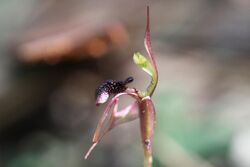Biology:Chiloglottis formicifera
| Common ant orchid | |
|---|---|

| |
| Scientific classification Error creating thumbnail: Unable to save thumbnail to destination
| |
| Kingdom: | Plantae |
| Clade: | Tracheophytes |
| Clade: | Angiosperms |
| Clade: | Monocots |
| Order: | Asparagales |
| Family: | Orchidaceae |
| Subfamily: | Orchidoideae |
| Tribe: | Diurideae |
| Genus: | Chiloglottis |
| Species: | C. formicifera
|
| Binomial name | |
| Chiloglottis formicifera Fitzg.[1]
| |
| Synonyms[1] | |
| |
Chiloglottis formicifera, commonly known as the common ant orchid,[2] is a species of orchid endemic to New South Wales. It has two broad leaves and a single narrow, greenish or reddish flower with a black, ant-like callus covering most of the upper surface of the labellum. There is a single record of this species from New Zealand.
Description
Chiloglottis formicifera is a terrestrial, perennial, deciduous, herb with two leaves 30–60 mm (1–2 in) long and 15–25 mm (0.6–1 in) wide. A single greenish or reddish flower 12–16 mm (0.5–0.6 in) long and 6–8 mm (0.2–0.3 in) wide is borne on a flowering stem 60–100 mm (2–4 in) high. The dorsal sepal is spatula-shaped, 10–12.5 mm (0.4–0.5 in) long and about 3 mm (0.1 in) wide. The lateral sepals are 9–10 mm (0.35–0.39 in) long, about 0.7 mm (0.03 in) wide and erect at the base then curve downwards. There is a glandular tip about 0.5 mm (0.02 in) long on the end of all three sepals. The petals are lance-shaped with the narrower end towards the base, 8–10 mm (0.3–0.4 in) long, about 3 mm (0.1 in) wide and turned strongly downwards. The labellum is diamond-shaped, 7–10 mm (0.3–0.4 in) long and 6–7.5 mm (0.2–0.3 in) wide with a narrow, shiny black, ant-like callus covering most of its upper surface. Flowering occurs from August to November.[2][3]
Taxonomy and naming
Chiloglottis formicifera was first formally described in 1877 by Robert D. FitzGerald and the description was published in his book Australian Orchids from a specimen collected "in a gully at the Kurrajong".[4] The specific epithet (formicifera) is derived from the Latin word formica meaning "ant"[5]:93 with the suffix -fera meaning "bear", "carry" or "have".[5]:187
Distribution and habitat
The common ant orchid grows in moist places in forest between the Northern Tablelands and Nowra.[2][3] There is a single historical record from Kaitaia in New Zealand.[6]
References
- ↑ 1.0 1.1 "Chiloglottis formicifera". World Checklist of Selected Plant Families (WCSP). Royal Botanic Gardens, Kew. http://wcsp.science.kew.org/namedetail.do?name_id=38971.
- ↑ 2.0 2.1 2.2 Jones, David L. (2006). A complete guide to native orchids of Australia including the island territories. Frenchs Forest, N.S.W.: New Holland. p. 141. ISBN 1877069124.
- ↑ 3.0 3.1 Jones, David L.. "Chiloglottis formicifera". Royal Botanic Garden Sydney. http://plantnet.rbgsyd.nsw.gov.au/cgi-bin/NSWfl.pl?page=nswfl&lvl=sp&name=Chiloglottis~formicifera. Retrieved 20 April 2018.
- ↑ "Chiloglottis formicifera". APNI. https://id.biodiversity.org.au/instance/apni/471548. Retrieved 20 April 2018.
- ↑ 5.0 5.1 Brown, Roland Wilbur (1956). The Composition of Scientific Words. Washington, D.C.: Smithsonian Institution Press.
- ↑ de Lange, Peter J.. "Chiloglottis formicifera". New Zealand Plant Conservation Network. http://www.nzpcn.org.nz/flora_details.aspx?ID=2362. Retrieved 20 April 2018.
External links
Wikidata ☰ Q15495723 entry
 |

